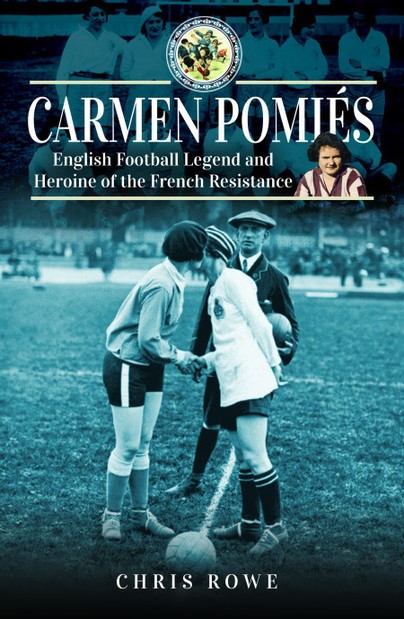Finding Carmen
27/04/2022 - 10.36
Chris Rowe
How does a historian come to write a book about a French female footballer, someone he had never even heard of until he was 78 years old? It’s an intriguing question, even for myself as the author. By 2019, I’d already had three careers in History: first as an academic lecturing at the University of Victoria in British Columbia, specialising in the Age Discovery; then as a teacher and examiner working at Winstanley College near Wigan, and writing several textbooks on the history of the twentieth century; then as a freelance consultant working with various international history projects across Europe. None of this had anything to do with Carmen Pomiès.
At the back of my mind, however, there was the germ of an idea linking football to teaching and learning about history. In one of my textbooks, Years of Division: Europe Since 1945, I wrote a chapter on society and culture in post-war Europe, trying to explain patterns of social change through the lives of three iconic footballers of different generations: Nat Lofthouse, Ferenc Puskas and Ruud Gullit.
Nat Lofthouse was a legend for Bolton Wanderers, a ‘one-club man’, tied to Bolton for his entire career. He belonged to an age when few players drove a car, or owned a house; they were ‘wage slaves’ controlled by their clubs through the maximum wage. Puskas was controlled in a different way. He was the superstar of Hungary’s ‘Golden Team’ but he was not rich or free, just a ‘slave’ to the Communist system. As an army officer, he was supposedly an amateur. But then came the 1956 Hungarian Rising. Puskas and many of the Golden Team escaped to the West. Puskas signed for Real Madrid and became a galactico, a celebrity in a very different football world than east of the Iron Curtain. Ruud Gullit was never a ‘slave’ like Lofthouse or Puskas. He was truly ‘modern’, a star in the Netherlands, Italy and England, as a player, a coach, and as a TV pundit. With an immigrant father from Surinam, he was also a symbol of modern multiculturalism. Gullit could never have been controlled the way Lofthouse always was or Puskas had been before he escaped from Hungary. As a confident ‘stroppy Dutchman’, Gullit knew his own worth; and that it was counted in millions.
That first venture in combining football and history planted an idea at the back of my mind. A few years later, working on History projects with EuroClio, I found there were colleagues with similar ideas and enthusiasms all across Europe - in the Netherlands, Germany, Italy, Croatia, Ireland, everywhere. We put forward plans to use football as a toolkit for teaching and learning about social history, with a special emphasis on themes like migration, identity, discrimination, diversity and equality.
Gradually, these aims came together in the footballmakeshistory.eu website. My special contribution to Football Makes History was going to be a collection of 100+ football life stories. This is how I got involved with Carmen Pomiès.
Choosing names for the life stories was not about ‘rounding up the usual suspects’ – the football stars everyone already knew about. Instead of a ‘Hall of Fame’, the idea was to get young people interested in the hidden histories beyond who won the most trophies, scored the most goals or played in the biggest leagues. Every life story had to have an important backstory: Black players and coaches held back by racism, Jewish footballers who died in Auschwitz, footballers subjected to homophobia, or were victims of alcoholism or depression. It was also immediately obvious that a substantial number of the life stories had to be women. I needed a crash course to teach myself the history of women’s football.
I did already have some idea about the origins of the women’s game in the 1880s and 1890s and how it was connected to things like Votes for Women and the Rational Dress Society. It was easy to choose names like ‘Nettie Honeyball’ and Mrs Graham’ (real name Helen Matthews). I knew a fair bit, too, about the story of Dick, Kerr Ladies and how ‘munitionettes football’ grew out of the First World War. So my list had to include names like Lily Parr, Florrie Redford and Lizzy Ashcroft. I’d read several books about Violette Morris, so I knew how important women’s football was in France in the 1920s and 1930s. Violette went on my list, along with Alice Milliat, known in France as the ‘Suffragette of Sport’. But, as I set about filling in the gaps in my knowledge, the name of Carmen Pomiès turned up, again and again.

Sporting Contest With Kisses. Source: Author's Collection
On the left hand side is the famous photo of Caren Pomiès and her close friend Florrie Redford, captains of the France and England teams at the kick-off, Herne Hill, London, 1925. The caption on the left reads - "International Competition in London. In a new fashion, instead of shaking hands, the lady captains kiss each other before the kick-off". The caption on the right reads - "Ball in hand, French captain Carmen Pomiès leads her team out on to the field of play with enthusiasm for the battle to come".
Carmen seemed to be everywhere. She played football, with and against Violette Morris and all the great names of the women’s game in France. Carmen was also a javelin thrower competing against Violette in major international competitions. Carmen often played for and against Dick, Kerr Ladies; she toured North America as a DKL player in 1922. She was best friends with Lily, Florrie and Lizzy. It turned out that Carmen was many times captain of the France team in internationals; and that she was very important as an administrator and ambassador for the game. So Carmen became one of the first life stories to be uploaded on Football Makes History.

Source: Author's Collection
Carmen Pomiès, captain of the French football team, prepares to dive from the high board into the pool at Blackpool, watched by Marjorie Thomas of the English team. The team of French lady footballers are renewing an old rivalry with Preston Ladies. The final match of the tour will be played on Wednesday at Macclesfield. The French girls are keeping fit at Blackpool, training on the beach and in the pool.
It did not stop there. The more I researched Carmen’s life, the more fascinating she became. Not only was she a top footballer, a posh girl from Paris for whom Preston became a second home. Her intellectual elder sister Hélène was author, editor and translator of several books. Younger brother Georges was a film star and an internationally famous modern dancer who died tragically in 1933, aged only 31. Carmen herself was secretary to a famous star of French cinema, Renée Saint Cyr.
It turned out that Carmen’s life was intertwined with much of the twentieth century history I had been teaching to my A-Level students. Her story also included being an activist in the French resistance against German occupation from 1940 to 1944. For at least fourteen years she lived in the United States after emigrating to Rochester NY in 1946. After Rochester, Carmen lived in New York City while working as a translator at the United Nations. It was fun acquiring Hélène’s books, digging out photographs, researching all the ships on which Carmen made her many crossings of the Atlantic. It was also tantalising to find so many gaps in her life story, especially after 1960, when she seemed to disappear into the mists of time.

The Deepdale Memorial to Dick, Kerr Ladies, installed 1917 - Carmen is third in the line, Lily Parr is first; Florrie Redford sixth. Source: Author's Collection
Carmen’s twentieth century was my century, too. I lived through sixty years of it. And what went before me was the time of my parents, aunties and uncles. I’d spent much of my career teaching about it. For a historian of my generation, Carmen’s life and times seem very familiar, even though for the first seventy-eight years of my life I had never even heard of Carmen Pomiès. There were also parallels and connections between Carmen’s story and my own. Like Carmen, I was madly enthusiastic about sport. Like Carmen, I was often a captain and organiser, as well as just a player. Carmen was twenty-two when she first crossed the Atlantic with Dick, Kerr Ladies; I was twenty-three when I sailed to New York on Queen Elizabeth, with the same sense of a once-in-a-lifetime experience as Carmen had forty years before. From 1967 I lived and worked in North America, on Vancouver Island. Like Carmen and so many European migrants to the Americas, I did not stay forever but came back home.

French Lines SS Liberté, Le-Havre-New York 1950. Carmen sailed home from France to New York on Liberté in 1954. Source: Author's Collection
So I knew the places in America where Carmen had played on the 1922 tour, or lived in after emigrating in 1946. I knew the northern towns where she played for or against the Dick, Kerr girls. I’d taught about the history of France and the United States in her lifetime. Finding out everything there was to know about Carmen took over my life, especially when the pandemic put my life on hold.
In this search, I was lucky to find willing helpers. A colleague at Football Makes History, Marcel Put, provided terrific support from the start. So did my elder brother, Ian, a former teacher of French who has travelled more widely round France than anyone I know. Helge Faller, who lives in Germany and knows more than anyone about the history of women’s football in Europe between the wars, has given me invaluable help with expert knowledge and permission to use invaluable visual sources. Steve Bolton, who is a historian, Twitter warrior and grandson of Lizzy Ashcroft, has been similarly generous with his huge archive and boundless energy. In Eindhoven in January 2020, I was lucky enough to make friends with an authentic star of women’s football, Petra Landers, who played many times for Germany. Petra’s inspiration had a lot to do with my trying to turn Carmen’s life story into a book.
My book, Carmen Pomiès: Football Legend and Heroine of the French Resistance, published by Pen & Sword History, should be in bookshops by the beginning of May. But the quest to find Carmen remains far from finished. Her story is a bit like a jigsaw puzzle with quite a few pieces missing altogether. It’s been possible to trace her football career in fine detail, and to find dozens of interesting photographs of her, but there are many unknowns. After 1960, it’s even not certain which country Carmen was living in. So the book is full of unanswered questions.

Partly, this is due to the Covid Factor, the pandemic that has placed people like me under house arrest for more than a year. In normal times, it would have been possible to travel widely in searching for more on Carmen’s story. Given the chance, Ian and I would have been in France searching for clues about the Pomiès family. It might have been possible to visit Rochester or New York to find what she may have been doing there. But the pandemic ruled that our search had to be at a distance, mostly online.
Some people have assumed this must be very frustrating, but that’s not the case. History can only ever be a work in progress, full of loose ends. Doubtless, one day someone will find evidence about Carmen that I’ve missed. Certainly, there are things in her life that will remain forever unknown. That’s OK with me. It’s the way History is and always will be. And, when you’ve just had your 80th birthday, there’s not much point in waiting until some new evidence might turn up!
Biography
Born in Liverpool in 1941, Chris studied History at the University of Liverpool, then undertook postgraduate studies in London, Vienna and Providence RI, USA. He was a Lecturer at the University of Victoria, BC, Canada from 1967, specialising in the Age of Discovery. While in Victoria, Chris met and married Tessa, a girl from Brighton. He played for British Columbia in the Canadian inter-provincial cricket championship in 1971.
Chris returned to England in 1972 and was Head of Department at Winstanley College, Wigan, until 2002. He is a Senior A-Level examiner, a role he has held from 1981 until the present day, specialising mostly in 20th century European history. Since 1998, Chris has been an author of A-Level textbooks on Britain, Europe and the USA.
After semi-retirement in 2002, Chris has worked as a freelance consultant across Europe on history education for the Council of Europe and EuroClio. Since 2016, he has been an editor for the online project - footballmakeshistory.eu, producing life stories linking football and history. One of his first lives was Carmen Pomiès, famous in Paris and Preston women’s football. Carmen was so interesting that he decided to write a book about her.



/prod01/wlvacuk/media/departments/digital-content-and-communications/images-2024/240624-Alumni-Awards-2024-Resized.jpg)
/prod01/wlvacuk/media/departments/digital-content-and-communications/images-18-19/220325-Engineers_teach_thumbail.jpg)
/prod01/wlvacuk/media/departments/digital-content-and-communications/images-2024/240627-UN-Speaker-Resized.jpg)
/prod01/wlvacuk/media/departments/digital-content-and-communications/images-2024/240320-Uzbekistan-Resized.jpg)
/prod01/wlvacuk/media/departments/digital-content-and-communications/images-2024/240229-The-Link-Resized.jpg)
/prod01/wlvacuk/media/departments/digital-content-and-communications/images-2024/240627-Lady-Aruna-Building-Naming-Resized.jpg)